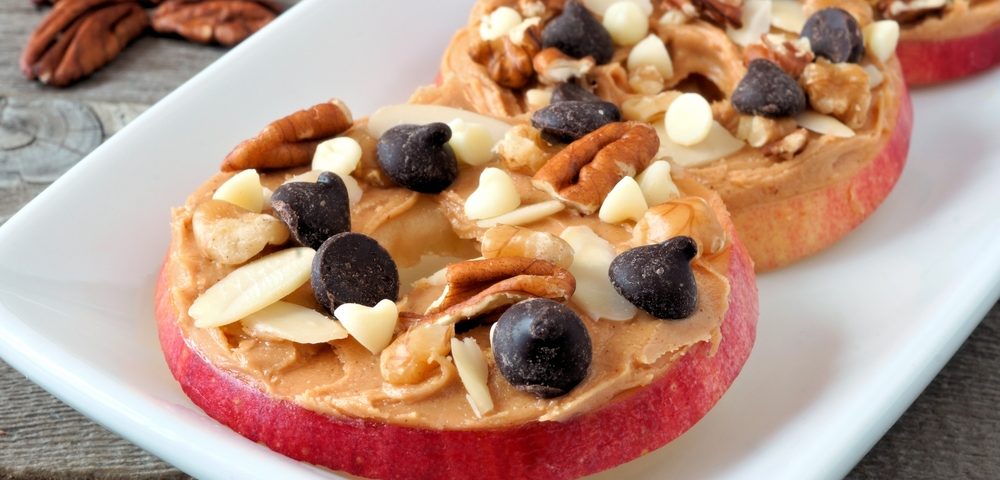Third in a series. Read part one and part two.
So, I’ve taken you through my basic go-to lunches and my favorite breakfasts – but what about snacks?
I used to snack pretty much all day, every day, and I was always hungry, no matter how big a meal I ate or how many servings I’d had. As I embark on my journey toward hormone balance, I’ve discovered that my constant hunger and need to snack are directly linked to my unstable blood sugar levels, which also have an impact on my fatigue and even on my endometriosis symptoms. I’ve been working to stabilize my levels ever since. You can read a bit more about my experience in a previous column.
Now that I eat for blood sugar and hormone balance, my snacking has changed. If I eat breakfast early, I’ll have a mid-morning snack. If not, I tend to eat an early lunch at about 12:30 p.m., and then I’ll have a snack around 3 or 3:30 p.m.
My go-to snack at the moment is a protein shake. I’ll mix it with water, or coconut or nut milk for extra flavor and nutrients. Depending on where I am in my cycle, I may add some fruit or other ingredients. I have to ease up on sugar during my pre-menstrual and menstrual phase. However, if I’m in my pre-ovulatory or ovulatory phase, I can afford to up my fruit intake.
I’m trying to eat for my cycle, according to the FLO Protocol, so in these phases, I might add strawberries, sour cherries, raspberries, figs, and coconut meat or milk. If you like a thicker type of smoothie, adding in a frozen banana (just be cautious if you find you get an increase of pain from sugar) or some avocado creates a beautiful creamy consistency. You could also add “superfoods” for a nutrient boost — raw cacao is great because it’s high in iron and magnesium, two minerals that are often lacking in those of us with endometriosis.
Some of my previous snack favorites have been almond- or coconut-based yogurt mixed with nuts, some fruit, and sometimes a scoop of protein powder to keep me going longer. I used to like chia puddings, too. Just mix up a batch of yogurt (I have dairy-free to reduce inflammation and because I’m intolerant) with chia seeds, and add whatever else you like to it. I added cacao nibs for crunch and oats to make it more filling. You then pop it in the fridge overnight and separate into jars or containers so you have a portion each day.
I also used to pick up some good gluten-free crackers and top them with peanut butter. It was a simple and filling snack, and I love peanut butter! You could do so much with this combo: Add some fruit on top or try different nut butter combinations and sprinkle with seeds. You could skip the crackers and have nut butter spread on apple slices instead.
Be wary of pre-packaged items. I’m not against convenience food at all — it’s convenient, and honestly I’m the last person to be making batches of snacks for the week ahead. However, in the past, before I fully understood what my body was responding to, my snacks consisted of fruit and nut bars, protein or energy balls, vegetable crisps, and other natural shop-bought snacks. These can be great, but be sure to check the ingredients list.
Many brands out there market themselves as “super healthy,” but the ingredients are a bit questionable or high in sugar. I try to keep my sugar levels down to reduce inflammation and have a low pain period, but if I’m eating these kinds of things every day, it doesn’t end well for me. So, try to be aware of how your body feels after the snacks you choose and keep a food diary so when you have a good period or bad period, you can begin to see a pattern.
If you are someone who likes getting into the kitchen (I do, but I have limited time!), then making up batch snacks can be really fun! You could try making savory fritters, chickpea flour tortilla chips, low-sugar oat cookies, or protein black bean brownies! If you’re more into your veggies, how about cutting up some vegetable crudités and making up some interesting hummus or dips for the week?
***
Note: Endometriosis News is strictly a news and information website about the disease. It does not provide medical advice, diagnosis, or treatment. This content is not intended to be a substitute for professional medical advice, diagnosis, or treatment. Always seek the advice of your physician or other qualified health provider with any questions you may have regarding a medical condition. Never disregard professional medical advice or delay in seeking it because of something you have read on this website. The opinions expressed in this column are not those of Endometriosis News or its parent company, BioNews Services, and are intended to spark discussion about issues pertaining to endometriosis.


